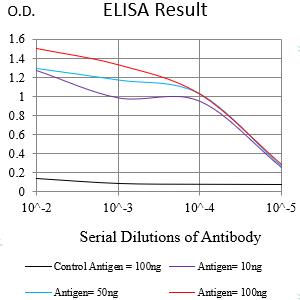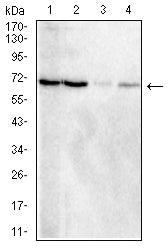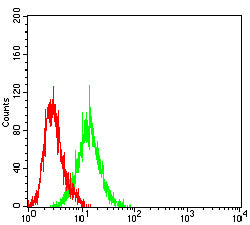


| WB | 1/500 - 1/2000 | Human,Mouse,Rat |
| IF | 咨询技术 | Human,Mouse,Rat |
| IHC | 咨询技术 | Human,Mouse,Rat |
| ICC | 技术咨询 | Human,Mouse,Rat |
| FCM | 1/200 - 1/400 | Human,Mouse,Rat |
| Elisa | 1/10000 | Human,Mouse,Rat |
| Aliases | TIM4; SMUCKLER |
| Entrez GeneID | 91937 |
| clone | 2A1H5 |
| WB Predicted band size | 41.6kDa |
| Host/Isotype | Mouse IgG1 |
| Antibody Type | Primary antibody |
| Storage | Store at 4°C short term. Aliquot and store at -20°C long term. Avoid freeze/thaw cycles. |
| Species Reactivity | Human |
| Immunogen | Purified recombinant fragment of human TIMD4 (AA: extra 25-314) expressed in E. Coli. |
| Formulation | Purified antibody in PBS with 0.05% sodium azide |
+ +
以下是关于TIMD4抗体的3-4篇参考文献及其摘要概括:
1. **文献名称**:*TIM-4 (TIMD4) is essential for macrophage-mediated clearance of apoptotic cells*
**作者**:Rodriguez-Manzanet, R. et al.
**摘要**:该研究通过构建TIMD4基因敲除小鼠模型,揭示了TIMD4在巨噬细胞吞噬凋亡细胞中的关键作用。使用特异性抗体阻断TIMD4功能后,凋亡细胞清除能力显著下降,并诱发系统性自身免疫反应,表明TIMD4在维持免疫稳态中的重要性。
2. **文献名称**:*TIM-4 co-stimulation enhances T cell activation and anti-tumor immunity*
**作者**:Miyanishi, M. et al.
**摘要**:研究发现TIMD4在活化的CD4+ T细胞表面表达,并通过与配体PS(磷脂酰丝氨酸)结合传递共刺激信号。抗TIMD4抗体在黑色素瘤模型中显著增强T细胞增殖及细胞因子分泌,抑制肿瘤生长,提示其作为免疫治疗靶点的潜力。
3. **文献名称**:*TIM-4 regulates allergic airway inflammation by dampening Th2 responses*
**作者**:Albacker, L.A. et al.
**摘要**:该研究探讨TIMD4在过敏性哮喘中的作用,发现TIMD4通过调控树突状细胞功能抑制Th2型免疫反应。使用中和性TIMD4抗体干预后,小鼠模型的气道嗜酸性粒细胞浸润和炎症加重,表明TIMD4可能通过负向调节过敏反应。
4. **文献名称**:*Structural basis of TIMD4 recognition of phosphatidylserine for apoptotic cell clearance*
**作者**:DeKruyff, R.H. et al.
**摘要**:通过X射线晶体学解析TIMD4与磷脂配体的结合结构,揭示了其特异性识别凋亡细胞表面磷脂酰丝氨酸的分子机制。研究基于结构设计出阻断型抗体,并在狼疮小鼠模型中验证其改善自身免疫表型的治疗效果。
这些文献涵盖了TIMD4在凋亡清除、肿瘤免疫、过敏调节及结构机制中的功能研究,均涉及抗体的实验应用。
TIMD4 (T-cell immunoglobulin and mucin domain-containing protein 4) is a transmembrane protein belonging to the TIM family, which plays a role in immune regulation and cell signaling. It contains an immunoglobulin variable (IgV) domain and a mucin-like domain, structurally resembling other TIM family members (e.g., TIM1. TIM3). TIMD4 is primarily expressed on immune cells, including T helper 2 (Th2) cells, regulatory T cells (Tregs), and antigen-presenting cells like dendritic cells and macrophages. Functionally, it acts as a phosphatidylserine (PS) receptor, mediating the recognition and clearance of apoptotic cells—a critical process in maintaining immune tolerance and preventing autoimmunity. TIMD4 also modulates T-cell activation and cytokine production, influencing Th2-driven immune responses and allergic inflammation.
TIMD4 antibodies are tools used to study its expression, localization, and interactions in immune pathways. They are employed in techniques such as flow cytometry, Western blotting, and immunohistochemistry to explore TIMD4's role in diseases like autoimmune disorders, asthma, and cancer. Research suggests TIMD4 may have dual roles in cancer: promoting tumor immune evasion by suppressing anti-tumor T-cell activity or enhancing anti-tumor immunity through dendritic cell regulation. Its involvement in checkpoint pathways has sparked interest in TIMD4-targeted therapies. However, its precise mechanisms remain under investigation, necessitating further studies using specific antibodies to dissect its context-dependent functions in health and disease.
×